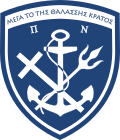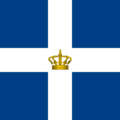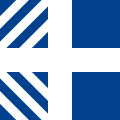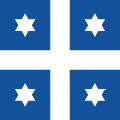Hellenic Navy
| Hellenic Navy Πολεμικό Ναυτικό - Polemikó Naf̱tikó | |
|---|---|
 Hellenic Navy Seal | |
| Active | 1821 (de facto) 1828 (official) |
| Country | |
| Role | National Defense |
| Size | over 30,000 Personnel 39 Warships 10 Submarines 6 Patrol Boats 57 Fleet Support & other Ships 21 Aircraft |
| Part of | Hellenic Armed Forces |
| Patron | St. Nicholas |
| Motto(s) | Μέγα το της θαλάσσης κράτος - Méga to ti̱s thalássi̱s krátos " The rule of the sea is a great matter"[1] |
| Colors | Blue, White & Gold |
| Engagements | Greek war of independence Balkan wars World War I World War II Operation UNIFIL Operation Desert Storm Operation Desert Shield Operation Sharp Guard Operation Enduring Freedom Operation Active Endeavour Operation IFITOS Operation Atalanta Operation Ocean Shield 2011 military intervention in Libya Operation Aginor War on Terror |
| Website | Hellenic Navy |
| Commanders | |
| Chief of the HN General Staff | Vice Admiral Evangelos Apostolakis |
| Chief of the Fleet Command | Vice Admiral Panagiotis Litsas |
| Notable commanders | Andreas Miaoulis Konstantinos Kanaris Pavlos Kountouriotis |
| Insignia | |
| Identification symbol | ΠΝ |
| Naval Ensign |  |
| Naval Jack & Pennant |  |
The Hellenic Navy (HN) (Greek: Πολεμικό Ναυτικό, Polemikó Naftikó, abbreviated ΠΝ) is the naval force of Greece, part of the Greek Armed Forces. The modern Greek navy has its roots in the naval forces of various Aegean Islands, which fought in the Greek War of Independence. During the periods of monarchy (1833–1924 and 1936–1973) it was known as the Royal Navy (Βασιλικόν Ναυτικόν, Vasilikón Naftikón, abbreviated ΒΝ).
The total displacement of all the navy's vessels is approximately 150,000 tons.
The motto of the Hellenic Navy is "Μέγα το της Θαλάσσης Κράτος" from Thucydides' account of Pericles' oration on the eve of the Peloponnesian War.[2][3] This has been roughly translated as "The rule of the sea is a great matter"[1] or as "Great is the country that controls the sea".[4] The Hellenic Navy's emblem consists of an anchor in front of a crossed Christian cross and trident, with the cross symbolizing Greek Orthodoxy, and the trident symbolizing Poseidon, the god of the sea in Greek mythology. Pericles' words are written across the top of the emblem.
"The navy, as it represents a necessary weapon for Greece, should only be created for war and aim to victory."
— Greek Government (1866)
History
The history of the Hellenic Navy begins with the birth of modern Greece, and due to the maritime nature of the country, it has always featured prominently in modern Greece's military history.
The Navy during the Revolution

At the beginning of the Greek War of Independence, the naval forces of the Greeks consisted primarily of the merchant fleet of the Saronic islanders from Hydra, Spetsai and Poros and also the islanders of Psara and Samos. The fleet was of crucial importance to the success of the revolt. Its goal was to prevent as much as possible the Ottoman Navy from resupplying the isolated Ottoman garrisons and land reinforcements from the Ottoman Empire's Asian provinces.
Although Greek crews were experienced seamen, the light Greek ships, mostly armed merchantmen, were unable to stand up to the large Turkish ships of the line in direct combat. So the Greeks conducted the equivalent of modern day naval special operations, resorting to the use of fireships ([πυρπολικά or μπουρλότα] Error: {{Lang-xx}}: text has italic markup (help)), with great success. It was in the use of such ships that courageous seamen like Constantine Kanaris won international renown. Under the leadership of capable admirals, most prominently Andreas Miaoulis of Hydra, the Greek fleet achieved early victories, guaranteeing the survival of the revolt in the mainland.

However, as Greece became embroiled in a civil war, the Sultan called upon his strongest subject, Muhammad Ali of Egypt, for aid. Plagued by internal strife and financial difficulties in keeping the fleet in constant readiness, the Greeks failed to prevent the capture and destruction of Kasos and Psara in 1824, or the landing of the Egyptian army at Modon. Despite victories at Samos and Gerontas, the Revolution was threatened with collapse until the intervention of the Great Powers in the Battle of Navarino in 1827. There the Egypto-Ottoman fleet was decisively defeated by the combined fleets of the Britain, France and the Russian Empire, effectively securing the independence of Greece.
When Ioannis Capodistrias became governor of newly liberated Greece in 1828, the Greek fleet consisted of few remaining ships, which had participated in the war for independence. The first minister of "Naval affairs" was Constantine Kanaris, and the most powerful ship of the fleet at that time, the frigate Hellas, had been constructed in the United States in 1825. The Hellenic Navy established its headquarters at the island of Poros and the building of a new series of ships began at the naval base[citation needed] while old ships were gradually being retired. Furthermore, continuous efforts towards the education of officers were initiated. Young people were initially trained at the military school of Scholi Evelpidon and afterwards they were transferred to the navy, as there was no such thing as a Naval Academy.[5]
In 1831, Greece descended into anarchy with numerous areas, including Mani and Hydra, in revolt. It was during this revolt that the flagship Hellas, docked at Poros, was set on fire by Admiral Andreas Miaoulis.[6] Capodistrias was assassinated a few months after.
The Royal Hellenic Navy of King Otto
When the new King Otto arrived in the Greek capital, Nafplion, in 1832 aboard the British warship HMS Madagascar, the Greek fleet consisted of 1 corvette, 3 brigs, 6 gollettes, 2 gunboats, 2 steamboats and a few more small vessels. The first Naval School was founded in 1846 on the Corvette Loudovikos and Leonidas Palaskas was assigned as its director. However the inefficient training of the officers, coupled with conflict between those who pursued modernization and those who were stalwarts of the traditions of the veterans of the struggle for independence, resulted in a restricted and inefficient navy, which was limited to policing the sea and the pursuit of pirates.
During the 1850s, the more progressive elements of the navy won out and the fleet was augmented with more ships. In 1855, the first iron propeller-driven ships were ordered from England. These were the steamships Panopi, Pliksavra, Afroessa, and Sfendoni.[5]
Growth of the Navy under King George


On October 29th, 1863, following an enthronement ceremony in his native Copenhagen and a tour of several of the European capitals, Prince Wilhelm of Denmark arrived aboard the Greek flagship Hellas, to take up the throne as King George I of Greece. During the 1866 Cretan revolt, the ships of the Royal Hellenic Navy were in no condition to support it. Such failure led to the government awakening to the problem of naval insufficiency and the adoption of a policy stating that: "The navy, as it represents a necessary weapon for Greece, should only be created for war and aim to victory." Because of this, the fleet was supplied with new and bigger ships, reflecting a number of innovations including the use of iron in shipbuilding industry and the invention of the torpedo; with these advances, the effectiveness and the appearance of the Hellenic Navy changed.
Meanwhile after 1878, because of the Russo-Turkish War and the need to expand the Greek navy, a new and larger naval base was established in the area of Faneromeni of Salamis and a few years later it was transferred to the area of Arapis where it remains today. At the same time the Naval Academy was founded and Ilias Kanellopoulos was made Director. A committee from France headed by Admiral Lejeune introduced a new, advanced naval organization and the methodological training of enlisted personnel through the establishment of a training school in the old building of the naval base in Poros. During the government of Charilaos Trikoupis in 1889, the fleet was further increased with the acquisition of new battleships:Hydra, Spetsai, and Psara from France. Thus, when Greece went to war in the Greco-Turkish War in 1897, the Hellenic Navy established its dominance in the Aegean Sea, however, it was unable to change the outcome of the war on land, which was a national humiliation.
In 1907, the Hellenic Navy General Staff (Γενικό Επιτελείο Ναυτικού) was founded, with then-Captain Pavlos Kountouriotis as its first head. After the war, in 1897, the Ottoman Empire embarked on a program of naval expansion for its fleet and as a response to that, in 1909, the cruiser Georgios Averof was bought from Italy. In 1910, an English naval mission arrived, headed by Admiral Tuffnel, in order to recommend improvements in the organization and training of the navy. The mission led to the adoption of the English style of management, organization and training, especially in the area of strategy.
Balkan Wars 1912-1913

The Navy, shortly before the Balkan Wars, was composed of a destroyer and battleship fleet. Its mission was primarily offensive, aiming at capturing the Ottoman-held islands of the Eastern Aegean, and establish naval supremacy in the area. To that end, its commander-in-chief, Rear Admiral Pavlos Kountouriotis, established a forward base at the Moudros bay at Lemnos, directly opposite the Dardanelles straits. After defeating the two Turkish sallies from the Straits at Elli (December 1912) and Lemnos (January 1913), the Aegean Sea was secured for Greece.
The Balkan Wars were followed by a rapid escalation between Greece and the Ottoman Empire over the as yet unclear status of the islands of the Eastern Aegean. Both governments embarked on a naval armaments race, with Greece purchasing the obsolete battleships Lemnos and Kilkis and the light cruiser Elli as well as ordering two dreadnoughts, the Vasilefs Konstantinos and the Salamis and a number of destroyers. However, with the outbreak of the First World War, construction of the dreadnoughts stopped.
World War I and after: 1914–1940

Initially during the war, Greece followed a course of neutrality, with the Prime Minister Eleftherios Venizelos favoring the Entente and pro-German King Constantine I advocating neutrality. This dispute eventually led to a deep political conflict, known as the "National Schism". In November 1916, in order to apply pressure on the royal government in Athens, the French confiscated the Greek ships. They continued to operate with French crews, primarily in convoy escort and patrol duties in the Aegean, until Greece entered the war on the side of the Allies in June 1917, at which point they were returned to Greece. Subsequently, the Greek Navy took part in the Allied operations in the Aegean, in the Allied expedition in support of Denikin's White Armies in the Ukraine, and in the operations of the Greco-Turkish War of 1919–1922 in Asia Minor.
After Greece's catastrophic defeat, the 1920s and early 1930s were a politically turbulent period, with the economy in a bad state,[citation needed] so the Navy received no new units, apart from the modernization of four destroyers and the acquisition of six French submarines in 1927 and four Italian destroyers in 1929.
World War II

In 1938, Greece ordered four modern Greyhound class destroyers in British shipyards, making a serious step towards modernization. The outbreak of war in Europe, however, allowed only two to be delivered. Greece entered World War II with a navy consisting of 2 battleships, 1 armoured cruiser, 14 destroyers, and six submarines.[7]
During the Greco-Italian War, the Navy took over convoy escort missions in the Ionian Sea and even embarked on three raids against the Italian supply convoys in the Strait of Otranto. The most important role was given to the submarines, which although obsolete, managed to sink several Italian cargo ships in the Adriatic.
But when Nazi Germany attacked Greece, the RHN suffered heavily at the hands of the Luftwaffe, with 25 ships, including the old battleship, now artillery training ship, Kilkis and the hulk of her sister Lemnos, lost within a few days in April 1941. It was then decided to shift the remaining fleet (one cruiser – the famous Georgios Averof – three destroyers and five submarines) to the join up with the British Mediterranean Fleet at Alexandria.
As the war progressed, the number of Hellenic Royal Navy vessels increased after the concession of several destroyers and submarines by the British Royal Navy. The most notable aspects of the Hellenic Royal Navy's participation in World War II include the operations of the destroyer Vassilissa Olga which, until sunk in Leros on September 23, 1943, was the most successful Allied destroyer in the Mediterranean Sea; the participation of two destroyers in Operation Overlord; and the story of the destroyer Adrias, which while operating close to the coast of Kalymnos in October 1943 hit a mine, resulting in the loss of the vessel's prow, while blowing the two-gun forward turret over the bridge. After some minor repairs at Gümüşlük Bay in Turkey the Adrias managed to return to Alexandria in a 400-mile (640 km) trip, even though all the forepart of the ship, up to the bridge, was missing.
Post-war era

After World War II, the Royal Hellenic Navy was significantly strengthened by the concession of British and Italian ships. The organisation also changed in line with modern naval doctrines of that era after the entrance into NATO in 1952. At the beginning of the 1950s, US military aid formed the core of the country's armed forces. The Royal Hellenic Navy received the first Bostwick-class destroyers which took on the name Beasts (Θηρία), while withdrawing the British ones.


The next significant change was during the early 1970s, when Greece was the first Mediterranean naval force to order missile-equipped Fast Attack Craft (Combattante II) and the Type 209 submarines, whereas US military aid continued in the form of FRAM II class destroyers. In 1979, Hellenic Navy placed an order in the Netherlands for two modern Standard class frigates (the Elli class). These were the first acquisitions of new main surface vessels, rather than the use of second-hand ships, in almost four decades.
1980 to present
The Hellenic Navy was enhanced to its maximum point during the last decade. The arrivals of Hydra class (MEKO 200 HN) and more Standard class frigates along with the orders for more missile corvettes, Poseidon class Type 209 submarine submarines and naval helicopters allowed the retirement of the obsolete vessels.
Greece also received four Charles F. Adams class destroyers from the US Navy in 1991-1992. All four have since been decommissioned since their electronics and armament were obsolete and they required large crews.
The advance continued when Greece ordered Type 214 submarines that feature an air-independent propulsion (AIP) system, Sikorsky S-70B-6/10 Aegean Hawk helicopters and Project 1232.2 Zubr class hovercraft from Russia and the Ukraine.
Recent plans included the modernization of Standard class frigates with new electronics and radar systems, the modernization of Glaukos and Poseidon class submarines with new sonars, electronics and air-independent propulsion engines (programs Neptune I/II).
Chain of Command
 |
| Organization |
|---|
| History |
| Standing Deployments |
Main Commands
- Γενικό Επιτελείο Εθνικής Αμύνης (ΓΕΕΘΑ) Hellenic National Defense General Staff
- Γενικόν Επιτελείον Ναυτικού (ΓΕΝ) Hellenic Navy General Staff
- Αρχηγείον Στόλου (ΑΣ) Fleet Headquarters
- Ναυτική Διοίκηση Αιγαίου (ΝΔΑ) Aegean Sea Naval Command, Piraeus 37°56′01″N 23°37′31″E / 37.93361°N 23.62528°E
- Ναυτική Διοίκηση Ιονίου (ΝΔΙ) Ionian Sea Naval Command, Patras 38°15′00″N 21°44′00″E / 38.25000°N 21.73333°E
- Ναυτική Διοίκηση Βορείου Ελλάδος (ΝΔΒΕ) Northern Greece Naval Command, Thessaloniki
- Διοίκηση Ναυτικής Εκπαίδευσης (ΔΝΕ) Navy Training Command
- Διοίκηση Διοικητικής Μέριμνας (ΔΔΜΝ) Paymaster Command
- Ναύσταθμος Σούδας Souda Bay Naval Dock Crete
- Ναύσταθμος Σαλαμίνας Salamis Naval Base 37°58′25″N 23°31′42″E / 37.97361°N 23.52833°E and 37°59′22″N 23°43′18″E / 37.98944°N 23.72167°E
- Υδρογραφική Υπηρεσία Hellenic Navy Hydrographic Service[8]
- Υπηρεσία Φάρων Lighthouse Service[9]
- Αρχηγείον Στόλου (ΑΣ) Fleet Headquarters
Combat Arms
- Διοίκηση Φρεγατών (ΔΦΓ) Frigate Command
- Διοίκηση Κανονιοφόρων (ΔΚΦ) Gunboat Command
- Διοίκηση Ταχέων Σκαφών (ΔΤΣ) Fast Attack Craft Command
- Διοίκηση Υποβρυχίων (ΔΥ) Submarine Command
- Διοίκηση Αμφιβίων Δυνάμεων (ΔΑΔ) Amphibious Assault Forces Command
- Greece does not have a marine corps established as a separate branch attached to the naval service. Instead, the Army includes the 32nd Marine Brigade (32η Ταξιαρχία Πεζοναυτών); the Navy provides the landing craft etc.
- Διοίκηση Υποβρυχίων Καταστροφών (ΔΥΚ) Underwater Demolition Command
- Διοίκηση Αεροπορίας Ναυτικού (ΔΑΝ) Fleet Air Arm
- Διοίκηση Ελικοπτέρων Ναυτικού (ΔΕΝ) Naval Helicopter Command, Kotroni Naval Fort, 38°08′31″N 23°57′03″E / 38.14194°N 23.95083°E
- 1η Μοίρα Ελικοπτέρων Ναυτικού (ΜΕΝ 1) Naval Helicopter 1st Squadron (AB-212 ASW), Kotroni Naval Fort, 38°08′31″N 23°57′03″E / 38.14194°N 23.95083°E
- 2η Μοίρα Ελικοπτέρων Ναυτικού (ΜΕΝ 2) Naval Helicopter 2nd Squadron (S-70B Aegean Hawk), Kotroni Naval Fort, 38°08′31″N 23°57′03″E / 38.14194°N 23.95083°E
- 353 Μοίρα Ναυτικής Συνεργασίας (353 ΜΝΑΣ) 353rd Naval Cooperation Squadron, joint operation with Hellenic Air Force 112 Combat Wing, Elefsis, currently with no active aircraft. 38°04′13″N 23°33′56″E / 38.07028°N 23.56556°E
- Ελικοσταθμός Αμφιάλης = Amfiali Heliport 37°59′30″N 23°34′28″E / 37.99167°N 23.57444°E
- Διοίκηση Ελικοπτέρων Ναυτικού (ΔΕΝ) Naval Helicopter Command, Kotroni Naval Fort, 38°08′31″N 23°57′03″E / 38.14194°N 23.95083°E
Combat Support Arms
- Διοίκηση Ναρκοπολέμου (ΔΝΑΡ) Minesweeper Command
Combat Service Support
- Σχολή Εξάσκησης Ναυτικής Τακτικής (ΣΕΝΤ) Naval Tactical Training School (under Fleet Headquarters)
Equipment
Ships and submarines
Ranks and insignia
Officers
| NATO code | OF-10 | OF-9 | OF-8 | OF-7 | OF-6 | OF-5 | OF-4 | OF-3 | OF-2 | OF-1 | ||||||||||||||
|---|---|---|---|---|---|---|---|---|---|---|---|---|---|---|---|---|---|---|---|---|---|---|---|---|
 
|
 
|
 
|
 
|

|

|

|

|

|

| |||||||||||||||
| Ναύαρχος Navarchos |
Αντιναύαρχος Antinavarchos |
Υποναύαρχος Yponavarchos |
Αρχιπλοίαρχος Archiploiarchos |
Πλοίαρχος Ploiarchos |
Αντιπλοίαρχος Antiploiarchos |
Πλωτάρχης Plotarchis |
Υποπλοίαρχος Ypoploiarchos |
Ανθυποπλοίαρχος Anthypoploiarchos |
Σημαιοφόρος Simaioforos | |||||||||||||||
- Simaioforos Epikouros Axiomatikos - Naval Cadet
- Simaioforos - Sub-lieutenant
- Anthypoploiarchos - Lieutenant (junior grade)
- Ypoploiarchos - Lieutenant
- Plotarchis - Lieutenant commander
- Antiploiarchos - Commander
- Ploiarchos - Captain
- Archiploiarchos - Commodore
- Ypronavarchos - Rear admiral
- Antinavarchos - Vice admiral
- Navarchos - Admiral
NCOs and enlisted
| NATO code | OR-9 | OR-8 | OR-7 | OR-6 | OR-5 | OR-4 | OR-3 | OR-2 | OR-1 | |||||||||||||||||||||||||||
|---|---|---|---|---|---|---|---|---|---|---|---|---|---|---|---|---|---|---|---|---|---|---|---|---|---|---|---|---|---|---|---|---|---|---|---|---|

|

|

|

|

|

|

|

|
 male |
 female |
male |
female | |||||||||||||||||||||||||
| Ανθυπασπιστής[a] Anthypaspistis |
Αρχικελευστής Archikelefstis |
Επικελευστής Epikelefstis |
Κελευστής Kelefstis |
Δίοπος Diopos |
Ναύτης Naftis | |||||||||||||||||||||||||||||||
- Naftis - Seaman
- Diopos - Able seaman
- Klirotos Kelefstis - Leading seaman (Conscripts only)
- Kelefstis - Petty officer
- Epikelefstis - Chief petty officer
- Archikelefstis - Senior chief petty officer
- Anthipaspistis - Warrant officer
Hellenic Navy Flags
-
Royal HN Naval Ensign (1833-1858).
-
Royal HN Naval Ensign (1863-1924 and 1935-1970).
-
Royal HN Naval Jack, 1935.
-
HN Naval Jack.
-
Minister of Defence flag.
-
HN 4-star Admiral's Flag.
-
HN Senior Officer's flag.
-
HN Commissioning Pennant.
Photo gallery
-
Admiral and War of Independence hero Constantine Kanaris (1793-1877).
-
Summer service uniform of a Leading Rating (Telegraphist), 1912
-
Admiral and President of Greece Pavlos Kountouriotis (1855-1935).
-
Portrait of Rear Admiral Sofoklis Dousmanis (1868-1952).
-
LST HS Syros, L-144, undergoing trials, 1964.
-
Frigates HS Spetsai, F-453 and HS Bouboulina, F-463, at Phaleron Bay.
-
Submarine S-120 Papanikolis (214 type) at HDW at Kiel.
-
Jason-class tank landing ship HS Chios at Phaleron Bay
-
Hydrographic vessel HS Nautilus A-478 in Syros harbour
-
HS Pandora A-419, a passenger ship connecting Piraeus Harbor and Salamis Naval Base.
-
HS Psara, F-454, in Operation "Enduring Freedom".
-
HN S-70B-6 Aegean Hawk
See also
- History of the Hellenic Navy
- List of active Hellenic Navy ships
- List of decommissioned ships of the Hellenic Navy
- Hellenic Naval Cadets Academy
- Greek Merchant Navy
References
- ^ a b Thucydides (1910). "1.143.5". The Peloponnesian War. London; New York: J. M. Dent; E. P. Dutton. At the Perseus Project.
- ^ Thucydides (1942). "1.143.5". Historiae in two volumes (in Greek). Oxford: Oxford University Press. At the Perseus Project.
- ^ Thucydides, History of the Peloponnesian War, 1.143.
- ^ "Address of Panos Kammenos, Deputy Minister for Mercantile Marine to the International Conference of Propeller Clubs" (in Greek). Ministry of Mercantile Marine, Aegean and Island Policy. 2007-10-04. Retrieved 2007-10-17.
- ^ a b Official website of the Hellenic Navy
- ^ Politics and Statecraft in the Kingdom of Greece, John Anthony Petropulos, Princeton University Press, 1968.
- ^ Vice Admiral C. Paizis-Paradellis, HN (2002). Hellenic Warships 1829-2001 (3rd Edition). Athens, Greece: The Society for the study of Greek History. p. 205. ISBN 960-8172-14-4.
- ^ http://www.hnhs.gr/
- ^ "Υπηρεσία Φάρων". Hellenicnavy.gr. Retrieved 2009-08-06.
- ^ "Διακριτικά Βαθμών Προσωπικού ΠΝ" [Insignia of Personnel Ranks]. hellenicnavy.gr (in Greek). Hellenic Navy. Retrieved 26 May 2021.
- ^ "Διακριτικά Βαθμών Προσωπικού ΠΝ" [Insignia of Personnel Degrees]. hellenicnavy.gr (in Greek). Hellenic Navy. Retrieved 26 May 2021.
Further reading
- Official Website of the Hellenic Navy. Note regarding copyright: The Hellenic Navy allows free use and distribution of images from their web site with proper attribution, however they have no set copyright policy for derivative work. See also appropriate template from Greek Wikipedia: el:Template:ΠΔΕΠΝ.
- Zisis Fotakis (2005). Greek Naval Strategy and Policy 1910-1919 (Naval Policy and History). Routledge. ISBN 978-0-415-35014-3.
- Andrew Toppan (2002). "World Navies Today: Greece". Retrieved 2008-07-04.: Excellent resource with details for ships of the Hellenic Navy. Caution: List not updated since 2002.
- Royal Hellenic or Greek Navy in World War I, including warship losses
Cite error: There are <ref group=lower-alpha> tags or {{efn}} templates on this page, but the references will not show without a {{reflist|group=lower-alpha}} template or {{notelist}} template (see the help page).























